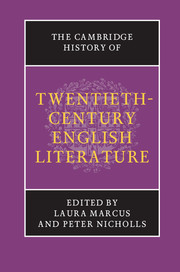Book contents
- Frontmatter
- Introduction
- PART ONE WRITING MODERNITY
- PART TWO THE EMERGING AVANT-GARDE
- PART THREE MODERNISM AND ITS AFTERMATH, 1918–1945
- 10 Trauma and war memory
- 11 The time–mind of the twenties
- 12 Modern life: fiction and satire
- 13 Modernist poetry and poetics
- 14 Modernity and myth
- 15 Psychoanalysis and literature
- 16 Biography and autobiography
- 17 ‘Speed, violence, women, America’: popular fictions
- 18 Theatre and drama between the wars
- 19 Literature and cinema
- 20 The thirties: politics, authority, perspective
- 21 Literary criticism and cultural politics
- 22 Surrealism in England
- 23 World War II: contested Europe
- 24 World War II: the city in ruins
- PART FOUR POST-WAR CULTURES, 1945–1970
- PART FIVE TOWARDS THE MILLENNIUM, 1970–2000
- Bibliography
- Index
- References
24 - World War II: the city in ruins
from PART THREE - MODERNISM AND ITS AFTERMATH, 1918–1945
Published online by Cambridge University Press: 28 March 2008
- Frontmatter
- Introduction
- PART ONE WRITING MODERNITY
- PART TWO THE EMERGING AVANT-GARDE
- PART THREE MODERNISM AND ITS AFTERMATH, 1918–1945
- 10 Trauma and war memory
- 11 The time–mind of the twenties
- 12 Modern life: fiction and satire
- 13 Modernist poetry and poetics
- 14 Modernity and myth
- 15 Psychoanalysis and literature
- 16 Biography and autobiography
- 17 ‘Speed, violence, women, America’: popular fictions
- 18 Theatre and drama between the wars
- 19 Literature and cinema
- 20 The thirties: politics, authority, perspective
- 21 Literary criticism and cultural politics
- 22 Surrealism in England
- 23 World War II: contested Europe
- 24 World War II: the city in ruins
- PART FOUR POST-WAR CULTURES, 1945–1970
- PART FIVE TOWARDS THE MILLENNIUM, 1970–2000
- Bibliography
- Index
- References
Summary
One of the most vivid literary descriptions of World War II occurs at the end of Evelyn Waugh’s Vile Bodies, which was published in 1930. If this seems a bit premature, it should be noted that prescient British observers had been predicting another war at least since the publication of John Maynard Keynes’s Economic Consequences of the Peace ten years earlier. Keynes had warned that, unless the peace terms extracted from Germany at Versailles were adjusted, there would be another war, ‘before which the horrors of the late German war will fade into nothing, and which will destroy, whoever is victor, the civilization and the progress of our generation’. This conviction of the utter ruin to be brought by another war grew over the next two decades, until it became widely assumed that the next war would mean the virtual collapse of civilisation in the UK, beginning with the physical destruction of British cities. Alexander Korda’s 1935 film version of H. G. Wells’s Things to Come gave a vivid and influential visual form to the assumption that another war would be fought primarily from the air by bombers whose penetration of civil defence perimeters was virtually assured. One military calculation predicted 600,000 civilian dead and 1.2 million wounded in the first six months of aerial bombardment. The use of gas in such attacks would mean, as Waugh has it in 1930, a civilian population going to bed each night in gas masks.
- Type
- Chapter
- Information
- The Cambridge History of Twentieth-Century English Literature , pp. 436 - 452Publisher: Cambridge University PressPrint publication year: 2005

